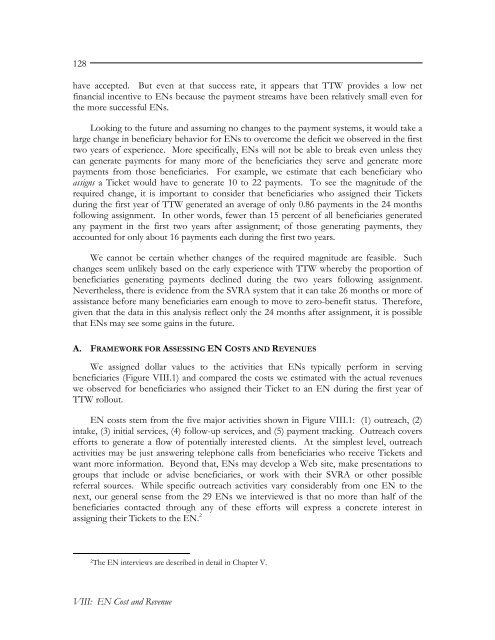Evaluation of the Ticket to Work Program, Implementation ...
Evaluation of the Ticket to Work Program, Implementation ...
Evaluation of the Ticket to Work Program, Implementation ...
You also want an ePaper? Increase the reach of your titles
YUMPU automatically turns print PDFs into web optimized ePapers that Google loves.
128have accepted. But even at that success rate, it appears that TTW provides a low netfinancial incentive <strong>to</strong> ENs because <strong>the</strong> payment streams have been relatively small even for<strong>the</strong> more successful ENs.Looking <strong>to</strong> <strong>the</strong> future and assuming no changes <strong>to</strong> <strong>the</strong> payment systems, it would take alarge change in beneficiary behavior for ENs <strong>to</strong> overcome <strong>the</strong> deficit we observed in <strong>the</strong> firsttwo years <strong>of</strong> experience. More specifically, ENs will not be able <strong>to</strong> break even unless <strong>the</strong>ycan generate payments for many more <strong>of</strong> <strong>the</strong> beneficiaries <strong>the</strong>y serve and generate morepayments from those beneficiaries. For example, we estimate that each beneficiary whoassigns a <strong>Ticket</strong> would have <strong>to</strong> generate 10 <strong>to</strong> 22 payments. To see <strong>the</strong> magnitude <strong>of</strong> <strong>the</strong>required change, it is important <strong>to</strong> consider that beneficiaries who assigned <strong>the</strong>ir <strong>Ticket</strong>sduring <strong>the</strong> first year <strong>of</strong> TTW generated an average <strong>of</strong> only 0.86 payments in <strong>the</strong> 24 monthsfollowing assignment. In o<strong>the</strong>r words, fewer than 15 percent <strong>of</strong> all beneficiaries generatedany payment in <strong>the</strong> first two years after assignment; <strong>of</strong> those generating payments, <strong>the</strong>yaccounted for only about 16 payments each during <strong>the</strong> first two years.We cannot be certain whe<strong>the</strong>r changes <strong>of</strong> <strong>the</strong> required magnitude are feasible. Suchchanges seem unlikely based on <strong>the</strong> early experience with TTW whereby <strong>the</strong> proportion <strong>of</strong>beneficiaries generating payments declined during <strong>the</strong> two years following assignment.Never<strong>the</strong>less, <strong>the</strong>re is evidence from <strong>the</strong> SVRA system that it can take 26 months or more <strong>of</strong>assistance before many beneficiaries earn enough <strong>to</strong> move <strong>to</strong> zero-benefit status. Therefore,given that <strong>the</strong> data in this analysis reflect only <strong>the</strong> 24 months after assignment, it is possiblethat ENs may see some gains in <strong>the</strong> future.A. FRAMEWORK FOR ASSESSING EN COSTS AND REVENUESWe assigned dollar values <strong>to</strong> <strong>the</strong> activities that ENs typically perform in servingbeneficiaries (Figure VIII.1) and compared <strong>the</strong> costs we estimated with <strong>the</strong> actual revenueswe observed for beneficiaries who assigned <strong>the</strong>ir <strong>Ticket</strong> <strong>to</strong> an EN during <strong>the</strong> first year <strong>of</strong>TTW rollout.EN costs stem from <strong>the</strong> five major activities shown in Figure VIII.1: (1) outreach, (2)intake, (3) initial services, (4) follow-up services, and (5) payment tracking. Outreach coversefforts <strong>to</strong> generate a flow <strong>of</strong> potentially interested clients. At <strong>the</strong> simplest level, outreachactivities may be just answering telephone calls from beneficiaries who receive <strong>Ticket</strong>s andwant more information. Beyond that, ENs may develop a Web site, make presentations <strong>to</strong>groups that include or advise beneficiaries, or work with <strong>the</strong>ir SVRA or o<strong>the</strong>r possiblereferral sources. While specific outreach activities vary considerably from one EN <strong>to</strong> <strong>the</strong>next, our general sense from <strong>the</strong> 29 ENs we interviewed is that no more than half <strong>of</strong> <strong>the</strong>beneficiaries contacted through any <strong>of</strong> <strong>the</strong>se efforts will express a concrete interest inassigning <strong>the</strong>ir <strong>Ticket</strong>s <strong>to</strong> <strong>the</strong> EN. 22 The EN interviews are described in detail in Chapter V.VIII: EN Cost and Revenue
















